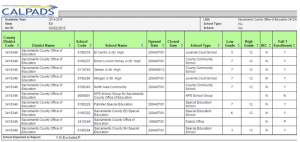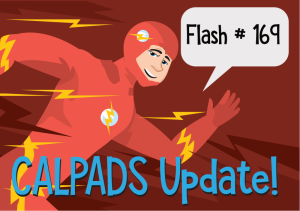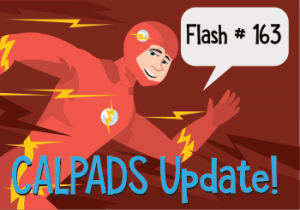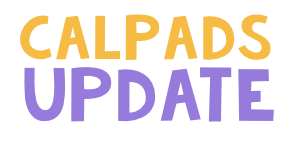CALPADS Update FLASH #284
When to Use an Individualized Family Service Plan (IFSP), Individualized Education Program (IEP), or an Individualized Service Plan (ISP) This Flash provides further specificity to Flash 161 regarding which plan types students with disabilities (SWD) should have. Individuals: Birth to 35 months should have an Individualized Family Service Plan (IFSP). Ages 3 to 5, should have an Individualized Education Program (IEP), even if the child is attending a private preschool, private transitional kindergarten, or private kindergarten (that is not a nonpublic, nonsectarian certified school). LEAs should enroll students ages 3 to 5 who are attending a private school at the district level, with the Re...
We are nearly finished with the build-out of the CALPADS reports section of the website. We've listed the 84 active reports (both certification and support). For each we list the name of the report, a screenshot, description, and list of the data elements (the actual headers of the report). Eventually we will add some additional info for each. Registered members can also post comments/questions/tips for each.
Disabling of the Student Discipline File on February 25, 2020 In preparation for implementing the new student incident files for the 2019–20 End-of-Year (EOY) 3 submission, the current Student Discipline (SDIS) file and User Interface will be disabled on February 25, 2020. Therefore, beginning February 25, 2020, LEAs will not be able to: Update historical SDIS information through batch or online.View Student Detail Discipline and historical Incident Discipline data in the CALPADS User Interface.Access Operational Data Store (ODS) versions of the discipline reports (reports 7.xx). Therefore, any updates to student discipline data in prior years in the CALPADS Operational Data Store must be ma...
Important Reminder to update the Student English Language Acquisition Status in CALPADS Prior to Summative Testing for the English Language Proficiency Assessment for California All English learners must be assessed annually with the Summative English Language Proficiency Assessment for California (ELPAC). In order to be tested, students must have an English Language Acquisition Status (ELAS) of English Learner (EL) in CALPADS. Therefore, it is critical that students' ELAS are up-to-date in CALPADS before the Summative ELPAC testing opens on February 3, 2020, in order that students may be tested. In addition, any students' initial ELAS statuses that have been corrected through one of the all...
Postsecondary Status File The CALPADS File Specifications (CFS) includes a new file, the Postsecondary Status (PSTS) file that will be implemented in 2019–20. This file will be used by LEAs to submit survey data to CALPADS that LEAs previously submitted to the CDE through the Perkins Data System (PDS) and the California Special Education Management Information System (CASEMIS), both of which are now retired. LEAs have generally collected the postsecondary status data for Career Technical Education (CTE) pathway completers and concentrators, and students with disabilities (SWD) who have completed secondary education, through a student survey. LEAs will now submit the data they have collected ...
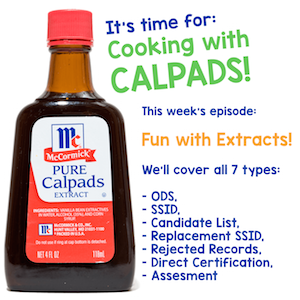
There are 9 types of CALPADS Extract files: 1. ODS Extracts 2. SSID Extract 3. Candidate List Extract 4. Replacement SSID Extract 5. Rejected Records Extract 6. Direct Certification Extract 7. Assessment - Student Results Extract New! 8. Assessment - Individual Student Results Extract New! 9. Suspense Resolution Records Type #1 - "Operational Data Store or 'O.D.S.' extract" Generating an ODS extract is useful if you want to compare the data in CALPADS to what is in your own SIS system. Since an ODS extract pulls out the "live" data, you can match what is in CALPADS to your own data to make sure you have enrolled or exited all of the students correctly, to identify students who might be participating in a program, determine the EL status, etc. There are 13 different types of ODS extract files. They are virtually identical to the files used to upload data to the calpads system from your student information system, with three differences: the ODS Extract file is structured like the input file with the addition of two fields, (A) the upload date and (B) the last date updated, at the end of each record. Additionally, the (C) Record Type Code will have a ‘-R’ appended to the Input Record Type Code. ODS Extract Record Type Codes # Record Type Input Record Type Code ODS Extract Record Type Code 1 SSID Enrollment SENR SENR-R 2 Student Information SINF SINF-R 3 Student English Language Acquisition SELA SELA-R 4 Student Program SPRG SPRG-R 5 Student Discipline SDIS SDIS-R 6 Student Waivers SWAV SWAV-R 7 Staff Demographics SDEM SDEM-R 8 Staff Assignment SASS SASS-R 9 Course Section Enrollment CRSE CRSE-R 10 Course Section Completion CRSC CRSC-R 11 Student Course Section Enrollment SCSE SCSE-R 12 Student Course Section Completion SCSC SCSC-R 13 Student Career Technical Education SCTE SCTE-R Type #2 - "SSID extract" An LEA may request an extract of their "State Student Identifier Number" or "SSID" information from the CALPADS portal. CALPADS will create the extract file according to the user’s specified selection criteria. The SSIDs in the file may be imported into a local student information system and/or used locally on the user’s personal computing system. The file will contain a list of SSIDs and limited demographics based on the selected filter criteria defined by the LEA. CALPADS will extract ONLY THE SSIDs associated with the students currently enrolled in the LEA. The content of the SSID Extract file is listed in the table below. SSID Extract Record Layout # CALPADS File Element Field Type Max Length Business Rule 1 Reporting LEA CS 7 This will default to the institution identifier of the User ID. May not be blank. 2 School of Attendance CS 7 The 7 digit code associated with the student’s school of attendance. May not be blank. 3 SSID CS 10 The SSID for the student. If the SSID associated with the enrollment is retired, the system will populate the SSID field with the active SSID associated with the retired...
Special Education Data Collection in CALPADS Beginning September 10, 2019, CALPADS will accept data related to Students with Disabilities (SWD) that were previously submitted to the CDE through the California Special Education Management Information System (CASEMIS). 14 page PDF file. File Name: calpadsupdflash161 File Size: 404 kb Download File
Changes in reporting for Multilingual and English Learner ProgramsThe attached CALPADS Update FLASH #163 (3 page PDF file) provides information about the following topics: New Language Instruction Program Codes for Native and Non-Native English SpeakersReporting English Learner Participation in Language Acquisition ProgramsReporting English Learner Services File Name: calpadsupdflash16_20190926-191911_1 File Size: 145 kb Download File
File Name: AB-2657-Implementation File Size: 299 kb Download File California Department of Education presentation that reviews the newly enacted AB2657 and the requirements for data collection in CALPADS and suggestions for best practices. 18 page PowerPoint file.


